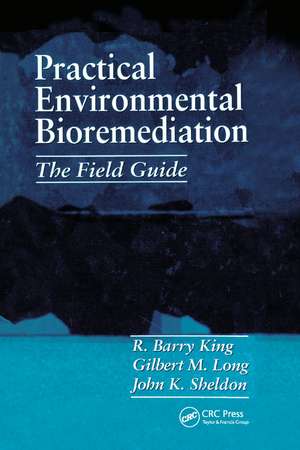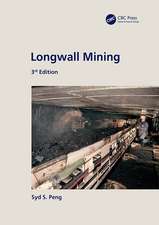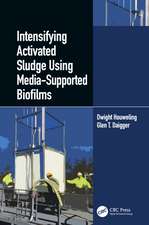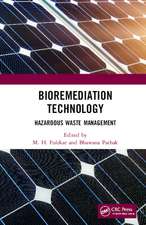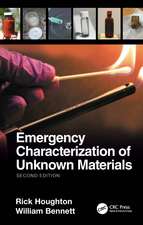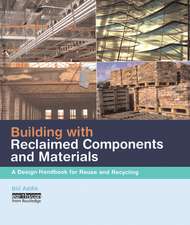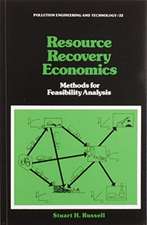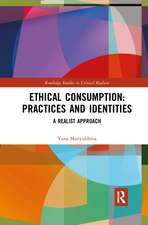Practical Environmental Bioremediation: The Field Guide, Second Edition
Autor R. Barry King, John K. Sheldon, Gilbert M. Longen Limba Engleză Paperback – 17 oct 2019
Bioremediation technology has witnessed great strides towards simplifying treatability formats, finding new approaches to field application, more potent nutrient formulations, monitoring protocols and the resulting general improvement in results. This new guide condenses all current available knowledge and presents necessary technical aspects and concepts in language that can be readily comprehended by the technical student, experienced scientist or engineer, the aspiring newcomer, or anyone else interested in this exciting natural cleanup technique.
| Toate formatele și edițiile | Preț | Express |
|---|---|---|
| Paperback (1) | 368.90 lei 6-8 săpt. | |
| CRC Press – 17 oct 2019 | 368.90 lei 6-8 săpt. | |
| Hardback (1) | 1273.03 lei 6-8 săpt. | |
| CRC Press – 29 dec 1997 | 1273.03 lei 6-8 săpt. |
Preț: 368.90 lei
Preț vechi: 476.44 lei
-23% Nou
Puncte Express: 553
Preț estimativ în valută:
70.59€ • 73.90$ • 58.41£
70.59€ • 73.90$ • 58.41£
Carte tipărită la comandă
Livrare economică 05-19 aprilie
Preluare comenzi: 021 569.72.76
Specificații
ISBN-13: 9780367400736
ISBN-10: 0367400731
Pagini: 208
Dimensiuni: 156 x 234 x 10 mm
Greutate: 0.38 kg
Ediția:2
Editura: CRC Press
Colecția CRC Press
ISBN-10: 0367400731
Pagini: 208
Dimensiuni: 156 x 234 x 10 mm
Greutate: 0.38 kg
Ediția:2
Editura: CRC Press
Colecția CRC Press
Public țintă
Academic and Professional Practice & DevelopmentCuprins
Introduction: A Historical Perspective Regulatory History Early Successes Discovery of Hydrocarbon-degrading Microbes Oils Spills Discovery of Metal-Detoxifying Microbes Three Bioremediation Treatment Approaches: Biostimulation Bioaugmentation Intrinsic Treatment Recent Advances in Bioremediation Technology The Chapters Ahead Microbial Nutrition and Environmental Requirements Microbial Ubiquity Microbial Nutrition Moisture Energy for Metabolism The Role of Oxygen Environmental Requirements Microbial Growth Acclimation Logarithmic Growth Stationary Phase Death Phase Bacterial Pathogens Microbial Survival Microbial Destruction of Environmental Pollutants Biomineralization vs. Biotransformation Biodegradation Processes for Organic Compounds Aerobic Respiration Anaerobic Respiration Fermentation Biooxidation in Wastewater Treatment Bioattachment Biosorption Biosolubilization Microbial Detoxification of Metals Halobacteria Mixed Populations Cometabolism Chlorinated Hydrocarbons Radiation Effects Acquired Radiation Resistance Radioactive Mixed Waste Treatment Constructed Wetlands The Bioremediation Laboratory Bioassessment Screening Studies Microbiological Assay Biotreatability Studies Microcosms Respirometry Bioreactors Choosing a Laboratory Applied Bioremediation : An Overview The Bioremediation Approach Intrinsic Bioremediation Selection Guide for Appropriate Biotechnology Soils and Sludges Liquids and Aqueous Solutions Project Organization Site Characterization Initial Bioassessment Testing Detailed Studies, Pilot Testing, and Process Design Procurement, Installation and Startup Process Monitoring and Operation Final Sampling and Closure Reporting and Management Anaerobic Treatment: Sans Oxygen Process Definition Anaerobic Degradation Pros and Cons of Anaerobic Treatment Types of Anaerobic Systems Digestors Anaerobic Activated Sludge Fixed-Film Units Anaerobic Rotating Biological Contractors (ARBCs) Fluidized Bed Reactors Upflow Anaerobic Sludge Blanket (UASB) Ex Situ Soil Treatment (Soil Cells) In Situ Anaerobic Remediation Design Considerations Applications for Anaerobic Treatment Surface Bioremediation of Soils and Sludges: Land Treatment Regulations Feasibility Testing Design and Construction Nutrient Application Operations and Monitoring Closure Variations Biopile Biovault Biopit Project Exercise How Much Soil? How Big an Area? Materials Watering System How Long Might It Take? Does the Buyer Need the Space? What Will the Conceptual Design Cost? Work Plan and Permits Excavation and Backfill Treatment Cell Construction Equipment Operating Costs Closure Bioreactors: The Technology of Total Control Introduction Process Definition Bioreactor Configurations Activated Sludge Sequencing Batch Reactors (SBRs) Rotating Biological Contactors (RBCs) Trickling Filters Soil Slurry Reactors Vapor Phase Bioreactors (Biofilters) Fixed-Film, Plug Flow Design Considerations Pilot Testing Installation and Startup Case History Conclusion In Situ Aquifer Bioremediation Hydrogeologic Variables Light vs. Dense NAPL Standard Pump-and-Treat Option In Situ Option Destroys Contaminants Non-Aqueous Phase Liquid Hydrogeology Microbiology Engineering Installation and Startup Operations and Monitoring Closure Lagoon Bioremediation Treatment Options Feasibility Testing Design Considerations Oxygen Injection Sludge Suspension Sludge Shearing Nutrient Supply Operation and Monitoring Closure Vadose Zone Bioremediation Bioventing Delineation Respironetry Design Considerations Process Monitoring Biosparging Future Trends in Development: The Road Ahead How We Got Here Specific Biostimulations Cometabolism Advanced Acclimations and Bacterial Enzymes Microbial Chelants and Surfactants Genetic Engineering Sequencing Treatments Vadose Zone Treatment The Road Ahead Metals Bioremediation Inorganics Fermentations Mixed Waste In Situ Bioremediation Intrinsic Enhanced Anaerobic Enhanced Aerobic Sequencing Anaerobic / Aerobic Bioaugmentation
Recenzii
"The authors make a point to correct some of the misuses of terminology commonly encountered in this field... a resource appropriate for professionals, graduate, and upper-division undergraduate students, and faculty."
-Choice
The strengths of this new bioremediation guide are the clear and concise manner in which the authors convey the fundamentals and practical aspects of many forms of bioremediation...The book is very well organized, and presents complex concepts in plain language while providing excellent discussions that detail the major bioremediation processes and considerations. The authors have succeeded in producing an informative guide offering many facts and concepts in a format that is enjoyable to read... The book will benefit practitioners and novices alike in the decision-making of where and how to implement bioremediation in the field."-Jean M. Neubeck, Consulting Hydrologist, Alpha Geoscience
"...This book on bioremediation provides a great deal of fundamental concepts and technical information necessary to understand and implement a bioremediation strategy at contaminated sites. The authors clearly and directly communicate the basics of bioremediation in plain language that will benefit laymen and practitioners of environmental science... the reading in both easy and informative."-Northeastern Geology and Environmental Sciences
"This very multi-disciplinary title is recommended for academic libraries and other special collections that cover the subject areas of environmental engineering, waste recovery, and environmental cleanup monitoring. However, it is more suitable as an overview of, or guide to, the subject rather than a ready reference source."-E-Streams, Vol. 2, No. 2, February 1999
-Choice
The strengths of this new bioremediation guide are the clear and concise manner in which the authors convey the fundamentals and practical aspects of many forms of bioremediation...The book is very well organized, and presents complex concepts in plain language while providing excellent discussions that detail the major bioremediation processes and considerations. The authors have succeeded in producing an informative guide offering many facts and concepts in a format that is enjoyable to read... The book will benefit practitioners and novices alike in the decision-making of where and how to implement bioremediation in the field."-Jean M. Neubeck, Consulting Hydrologist, Alpha Geoscience
"...This book on bioremediation provides a great deal of fundamental concepts and technical information necessary to understand and implement a bioremediation strategy at contaminated sites. The authors clearly and directly communicate the basics of bioremediation in plain language that will benefit laymen and practitioners of environmental science... the reading in both easy and informative."-Northeastern Geology and Environmental Sciences
"This very multi-disciplinary title is recommended for academic libraries and other special collections that cover the subject areas of environmental engineering, waste recovery, and environmental cleanup monitoring. However, it is more suitable as an overview of, or guide to, the subject rather than a ready reference source."-E-Streams, Vol. 2, No. 2, February 1999
Notă biografică
King, R. Barry; Sheldon, John K.; Long, Gilbert M.
Descriere
Bioremediation technology has witnessed great strides towards simplifying treatability formats, finding new approaches to field application, more potent nutrient formulations, monitoring protocols and the resulting general improvement in results. This guide condenses just about everything there is to know about bioremediation and presents necessary technical aspects and concepts in language that can be readily comprehended by the technical student, experienced scientist or engineer, the aspiring newcomer, or anyone else interested in this exciting natural cleanup technique. The text provides data from actual site closures to illustrate and amplify understanding of specific applications.
